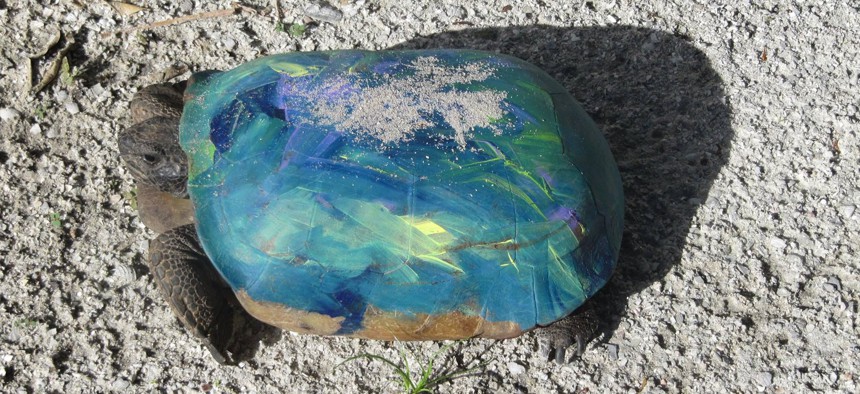Florida Wildlife Agency: Don’t Paint Turtles or Tortoises

Please don't paint the turtles and tortoises. Photo courtesy Florida Fish and Wildlife Conservation Commission
Authorities are trying to discourage people from engaging in a practice that is harmful to the shelled reptiles, and can be illegal under Florida state law.
Responding to turtles and tortoises that have turned up with decorated shells, a Florida wildlife agency is asking people to resist any urge they might have to emblazon the reptiles with paint.
“You should never paint the shells of turtles and gopher tortoises!” the Florida Fish and Wildlife Conservation Commission said in an appeal posted on its Facebook page late last month. It noted that painting a gopher tortoise’s shell is, in fact, illegal under Florida law.
The post explained that applying paint to the reptiles is harmful for a number of reasons.
For instance, it can inhibit their ability to absorb vitamins they need from sunlight, cause breathing problems, and expose the animals to toxic chemicals. Putting paint or nail polish on the shell of a turtle or tortoise can also make it easier for predators to spot.
The Fish and Wildlife Conservation Commission shared photos online of reptiles that had fallen victim to the ill-advised paint jobs.
One image shows a gopher tortoise with its shell painted bright red. After the tortoise was discovered, a wildlife rehabilitator was able to remove most of the paint.

Gopher tortoises are a threatened species in Florida, protected by state law.
Residing in a variety of places, including forests, pastures and yards, the tortoises dig burrows for shelter and forage on plants for food. They typically average about 9 to 11 inches in length, with tan, brown, or gray-colored shells, and shovel-like front limbs adapted for digging.

The tortoises can live 40 to 60 years in the wild, according to the Conservation Commission.
One notable aspect of gopher tortoise behavior is that they are known to share their burrows with over 350 other species, including owls, mice, snakes, opossums, rabbits and frogs.
The Miami Herald first reported on the fish and wildlife commission’s Facebook post on Sunday.
If a person comes across a turtle or tortoise that has been painted, the commission cautions against trying to remove the paint, and advises instead that they call the agency.
Depending on the location of the paint, and how long it was on one of the reptiles, it can leave stains even after cleaning.
Bill Lucia is a Reporter for Government Executive's Route Fifty and is based in Washington, D.C.
NEXT STORY: Governors tackle prescription drug abuse






